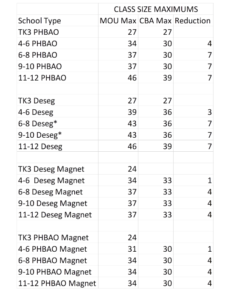State & district class size laws and policies
A map produced by Education Week shows the states that had class size limits or policies as of 2010, including many that had relaxed their policies since 2008.
The Education Commission of the States lists many of the state class size policies as of 2016 here with an update here.
Here are some notable examples of class size policies and limits found at state and local levels.
Florida (2002) – Statewide Constitution limits Class Sizes in all Grades
- Cap of 18 students in prekindergarten through grade 3;
- Cap of 22 students in grades 4 through 8; and
- Cap of 25 students in grades 9 through 12.
- As of 2015-6 school year, Florida statewide class size averages were 15.45 students per class in PK-3, 17.96 students per class in 4-8 grades, and 18.92 students per class in high school classes
Idaho (03/22/16) – Establishes Provisions Regarding Statewide Avg. Class Size
- Amends existing law to establish provisions regarding the statewide avg. class size.
- Allows for comparisons of school districts based on their student enrollment.
Nevada (06/11/15) – School Funding for 2015-17 Biennium
- Provides funding to reduce class-sizes and provides guidelines for districts to comply with required ratio of pupils to teachers.
- Funding may be applied first to pupils considered at risk of failure.
- The money transferred for class size reduction must not be distributed to a school districts unless that school district has:
- Filed with the DOE a plan for achieving the required ratio set forth in NRS 388.720.
- Demonstrated that enough classroom teachers have been employed to maintain the avg. pupil-teacher ratio.
North Carolina (04/01/2017) – HB 13
- Updates the long-standing NC class size law so that class sizes in grades K-3 are lowered over two years starting in 2017-2018 school year.

-
Requires a district-wide average class size of 20 students in Kindergarten- 3rd grade and a maximum of 23 students per class in the 2017-18 school year
Requires a district-wide average class size of 18 in Kindergarten and a maximum class size of 21 in the 2018-2019 school year
Requires a district-wide average class size of 16 in 1st grade and a maximum class size of 19 in the 2018-2019 school year.
Requires a district-wide class size average of 17 and a maximum class size of 20 in grades 2-3 in the 2018-19 school year.
Requires more detailed reporting on spending to ensure that the class size funds are spent correctly.
Oregon (07/22/15) – Task Force on Class Size
- Established to determine the appropriate class sizes of students, to identify methods to reduce class sizes and to determine the cost to reduce class sizes.
- Task force consisted of 15 members appointed by the President of the senate, Speaker of the House of Representatives, and the Governor.
Texas state law – Class Size and Student to Teacher Ratio
- Each district must maintain an avg. ratio of 20 students for one teacher.
- Caps of 22 students in kindergarten through grade 4; except for during the last 12 weeks of the school year.
- Districts with high migrant population may exceed the 22 to 1 ratio during a different 12 week period but it must be specified by the district.
- Districts that obtain waivers from the limit must provide written notice to the parents of each affected student.
Virginia state law (04/01/16) – Class Size Limit Parent Notification
- Requires school districts to notify parents within 10 days if a class exceeds established class size limit, including the reason as to why the class size limit has been exceeded.
- Student : Teacher Ratio
- K: 24 > 1, if students exceed 24, a full-time teacher’s aide shall be assigned
- Grades 1-3: 24 >1, no class larger than 30
- Grades 4-6: 25 >1, no class larger than 35
- Grades 6-12 (English Classes Only): 24 >1
Los Angeles, California (1/22/19) – tentative Union Contract
- Re-establishes a hard cap on class size and lowers class size over the next
 four years. According to the summary on the UTLA website:
four years. According to the summary on the UTLA website:
An immediate reduction of 7 students in secondary math and English classes. This is along with a complete elimination of Section 1.5, which had previously allowed the district to unilaterally ignore all class size averages and caps.
All class size caps are now based on an enforceable MOU. The current MOU, which dates 2017-2018, is now enforceable and will continuously be reduced over the next 4 years. Reduction in class sizes by norm day is as follows and additional equity investment will reduce some class sizes throughout all 4 years:
• 2019-2020 – reduction of 1 student per grade level, and an immediate reduction in secondary from an unenforceable 46 to a now enforceable 39 for ELA and Math.
• 2020-2021 – reduction of 1 additional student per grade level (2 aggregate)
• 2021-2022 – reduction of 2 additional students per grade level (4 aggregate)
• Effective by norm day 2022, the district shall comply with the class size averages and maximums in Section 2.0.
As demonstrated in the chart above.
San Diego, California (2014-2017) – Union Contract
- The “hard cap” on class size became effective July 1, 2012
- TK – Grade 3: 24 students
- Grade 4-6: 32 students
- Secondary: 36 students
Boston, Massachusetts (09/01/10) – Union Contract
- These caps on class size became effective September 1, 2013.
- K- Grade 2: 22 students
- Grades 3-5: 25 students
- Grades 6-8: 28 students
- Grade 9-12: 31 students
New York City, NY – Union Contract
- Pre-K: caps 18 students with a teacher plus a paraprofessional
- Kindergarten: caps classes at 25 students
- Grades 1-6 in elementary schools: caps classes at 32 students
- JHS/MS (all grades 4 – 8 or 5 – 9, if located in a middle school): 33 students in non-Title I schools; 30 in Title I schools.
- HS: caps classes at 34 students; 50 in Physical Education/Gym or Music








